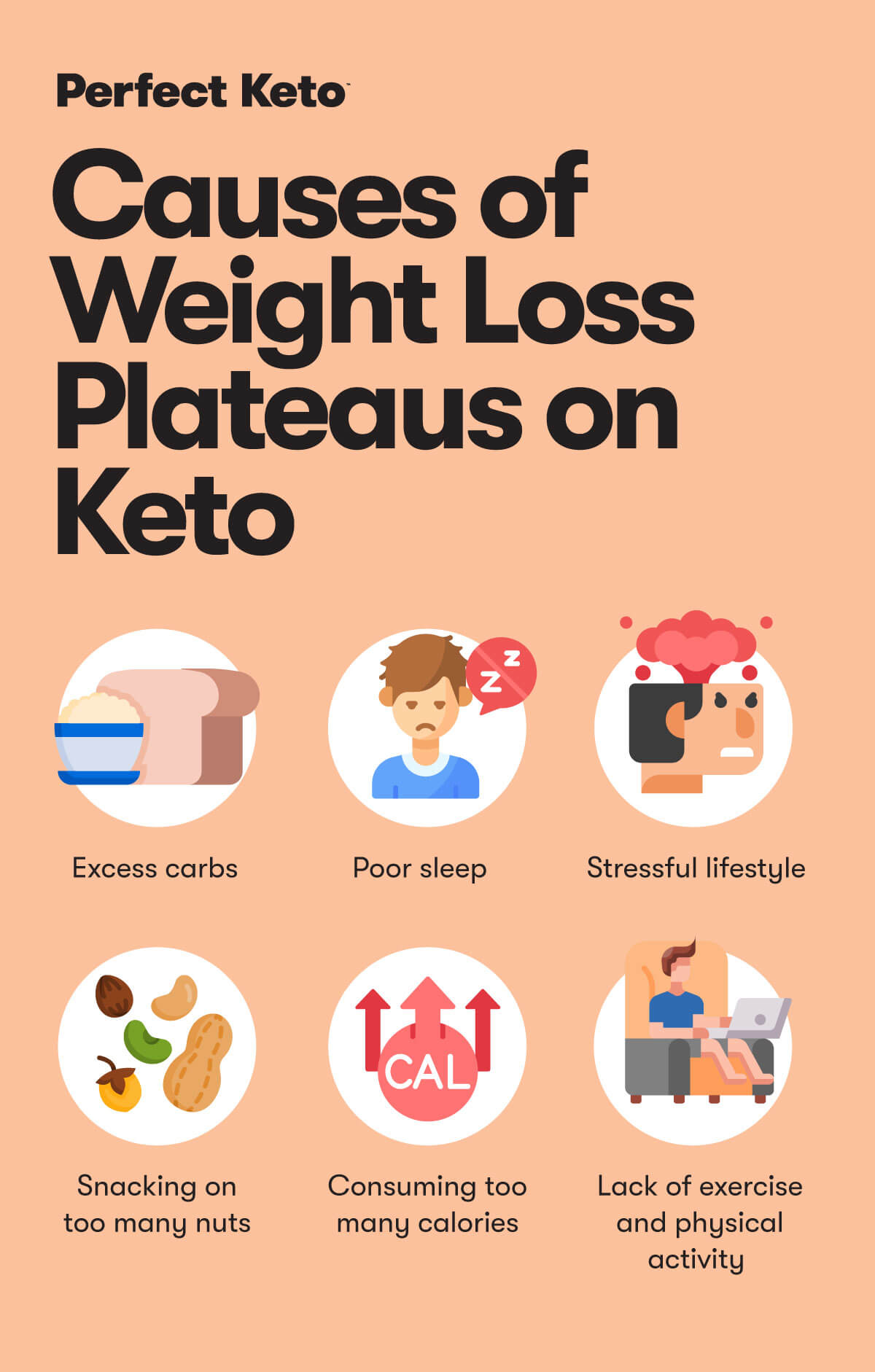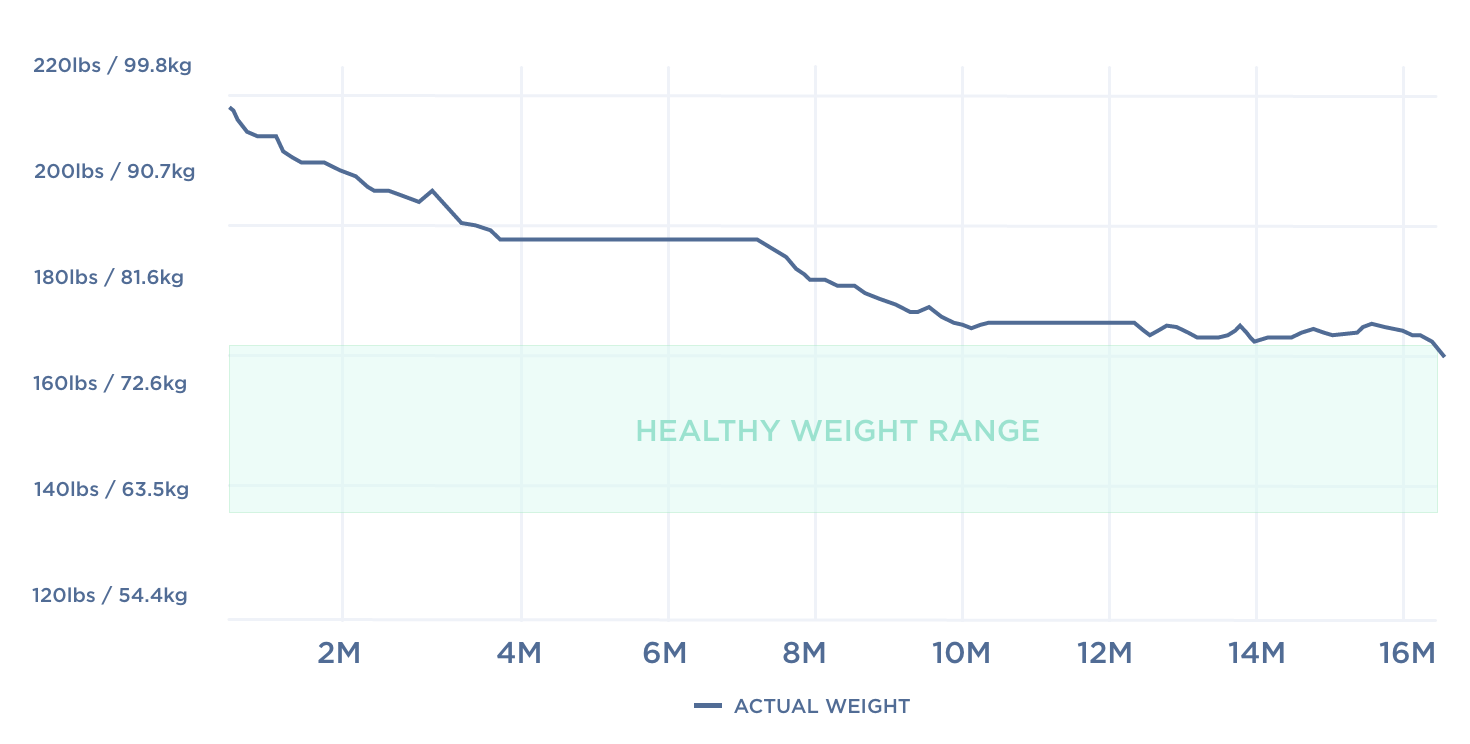Weight loss plateaus typically occur after a few weeks to several months of consistent dieting and exercise. The duration varies per individual.
Weight loss plateaus are common and can be frustrating. They usually happen after initial success when your body adapts to new routines. Your metabolism slows down, making further weight loss challenging. This is a natural response as your body seeks balance.
To overcome plateaus, you may need to adjust your diet or exercise regimen. Incorporating strength training and varying your workouts can help. Consulting a healthcare professional for personalized advice is beneficial. Staying consistent and patient is key to breaking through plateaus and achieving long-term weight loss goals.

Credit: perfectketo.com
Weight Loss Plateau Basics
Understanding a weight loss plateau is important for anyone on a fitness journey. It can help you stay motivated and adjust your strategies effectively.
Definition
A weight loss plateau happens when your weight stops decreasing. It can occur despite your efforts to maintain a diet and exercise routine. The body reaches a point where it needs fewer calories to function. This makes further weight loss more difficult.
Common Causes
Several factors contribute to a weight loss plateau:
- Metabolic Adaptation: As you lose weight, your metabolism slows down.
- Caloric Intake: Your body needs fewer calories after losing weight.
- Exercise Habits: Your body becomes efficient with regular exercise.
- Muscle Mass: Loss of muscle can reduce your metabolic rate.
| Cause | Description |
|---|---|
| Metabolic Adaptation | Slowed metabolism due to weight loss. |
| Caloric Intake | Reduced calorie needs after weight loss. |
| Exercise Habits | Body efficiency with regular exercise. |
| Muscle Mass | Loss of muscle reduces metabolic rate. |
Recognizing these causes can help you overcome a plateau. Adjust your diet and exercise to continue losing weight effectively.
Signs Of A Plateau
Recognizing the signs of a plateau is crucial in any weight loss journey. A plateau can be discouraging but understanding the indicators can help you overcome it. Here are some key signs to watch for:
Stalled Progress
One of the first signs of a plateau is stalled progress. If your weight stays the same for weeks, you may have hit a plateau.
- Weight remains unchanged for 2-4 weeks.
- No change in body fat percentage.
- Difficulty losing those last few pounds.
Body Measurements
Another indicator is a lack of change in body measurements. Even if the scale doesn’t move, body measurements can tell a different story.
| Measurement Area | Sign of Plateau |
|---|---|
| Waist | No reduction in inches |
| Hips | Same size for weeks |
| Thighs | No change in circumference |
Tracking your measurements can provide a clearer picture of your progress.
Psychological Impact
The psychological impact of a weight loss plateau can be significant. When progress stalls, it can lead to a range of emotional and mental challenges. Understanding these impacts can help you navigate this difficult phase.
Motivation Challenges
One of the biggest challenges during a weight loss plateau is maintaining motivation. It can be disheartening to see no changes despite your efforts.
- Feeling stuck can diminish your enthusiasm.
- You might question your methods and choices.
- Reduced motivation can lead to skipping workouts.
Staying motivated is crucial. Set small, achievable goals to keep your spirits high.
Emotional Responses
A weight loss plateau can trigger various emotional responses. These emotions can affect your overall well-being.
| Emotion | Impact |
|---|---|
| Frustration | Can lead to negative thoughts. |
| Disappointment | May cause you to give up. |
| Self-doubt | Can lower your self-esteem. |
Recognizing these feelings is the first step to overcoming them. Talk to friends or a coach for support.
Diet Adjustments
Weight loss plateaus can be frustrating. Diet adjustments can help you overcome them. Making changes to your diet can reignite your weight loss journey.
Caloric Intake
Caloric intake plays a big role in weight loss. You need to eat fewer calories than you burn. But eating too few calories can slow your metabolism. Find a balance.
Track your daily calorie intake. Adjust based on your weight loss progress. Use a table to record your calories:
| Day | Calories Consumed | Calories Burned |
|---|---|---|
| Monday | 1500 | 2000 |
| Tuesday | 1600 | 2100 |
| Wednesday | 1400 | 2200 |
Nutrient Timing
Nutrient timing affects how your body uses food. Eating the right foods at the right times can boost your metabolism.
Consider these tips:
- Eat protein-rich meals after workouts.
- Have small, frequent meals to keep your metabolism active.
- Avoid heavy meals before bedtime.
Track your meal times and nutrient intake. Adjust if you notice a plateau. Use the following format:
| Meal | Time | Type |
|---|---|---|
| Breakfast | 7:00 AM | High Protein |
| Lunch | 12:00 PM | Balanced |
| Snack | 3:00 PM | Light |
| Dinner | 6:00 PM | Low Carb |
Exercise Modifications
Weight loss plateaus can be frustrating. Sometimes you need exercise modifications to break through. Small changes in your routine can help. Let’s explore some effective exercise modifications.
Strength Training
Strength training builds muscle mass. This can boost your metabolism. Try lifting heavier weights. You can also increase the number of reps. Focus on different muscle groups each day.
Key exercises:
- Squats
- Deadlifts
- Bench Press
These exercises target multiple muscles. They can help you burn more calories. Keep your form correct to avoid injury.
Cardio Variations
Cardio exercises are great for burning calories. But doing the same routine can lead to a plateau. Switch up your cardio workouts.
Examples of cardio variations:
- Running
- Cycling
- Swimming
Try high-intensity interval training (HIIT). HIIT involves short bursts of intense activity. It can be very effective for weight loss.
| Exercise | Duration | Calories Burned |
|---|---|---|
| Running | 30 minutes | 300 |
| Cycling | 30 minutes | 250 |
| Swimming | 30 minutes | 200 |
Remember to listen to your body. Rest is also important. Adjust your exercises to your fitness level.

Credit: www.withings.com
Lifestyle Factors
Weight loss plateaus can be frustrating. Lifestyle factors often play a significant role. Two key aspects include sleep quality and stress management. Addressing these can help you overcome plateaus.
Sleep Quality
Good sleep is crucial for weight loss. Poor sleep can disrupt your hormones. This can lead to increased hunger and cravings. Aim for 7-9 hours of sleep each night.
Here are some tips for better sleep:
- Maintain a consistent sleep schedule.
- Keep your bedroom cool and dark.
- Avoid screens before bedtime.
- Limit caffeine intake after noon.
Improving sleep quality can boost your metabolism. This helps in breaking through weight loss plateaus.
Stress Management
Stress can lead to weight gain. High stress levels increase cortisol, a hormone that promotes fat storage. Managing stress can help you avoid weight loss plateaus.
Effective stress management techniques include:
- Practice mindfulness or meditation.
- Engage in regular physical activity.
- Connect with friends and family.
- Take up a hobby you enjoy.
Reducing stress helps balance your hormones. This can help you continue losing weight.
By focusing on sleep quality and stress management, you can tackle weight loss plateaus more effectively.
Tracking Progress
Tracking progress is essential for overcoming weight loss plateaus. It helps identify patterns and areas for improvement. There are various tools available to track your journey effectively.
Food Journals
Food journals are a great way to monitor your eating habits. Writing down every meal helps you stay accountable. It also makes it easier to spot unhealthy choices.
Consider the following benefits:
- Identifies calorie intake
- Highlights nutrient deficiencies
- Tracks emotional eating patterns
Here is a simple table to help you start:
| Meal | Food Items | Calories |
|---|---|---|
| Breakfast | Oatmeal, Banana | 300 |
| Lunch | Grilled Chicken Salad | 400 |
| Dinner | Salmon, Broccoli | 500 |
Fitness Apps
Fitness apps offer a convenient way to track exercise routines. They provide detailed insights into your physical activity.
Key features of fitness apps:
- Track workout intensity
- Count steps
- Monitor heart rate
Popular apps include:
- MyFitnessPal
- Fitbit
- Strava
Using these tools can make your weight loss journey more manageable. They help you stay on track and motivated.

Credit: hellodoctor.com.ph
Professional Support
Weight loss plateaus can be frustrating, but professional support can help. Seeking guidance from experts can provide personalized strategies to break through the plateau.
Nutritionists
A nutritionist can create a customized meal plan. They ensure you get balanced nutrients. This plan can help boost your metabolism and aid weight loss. Nutritionists can identify any dietary gaps. They might suggest vitamins or supplements. Regular check-ins with a nutritionist can keep you on track. They also help adjust your diet based on your progress.
Personal Trainers
A personal trainer can design a workout plan suited to your needs. They ensure you perform exercises correctly to avoid injury. Trainers can introduce new exercises to challenge your body. This helps prevent workout boredom and keeps you motivated. Personal trainers also help track your progress. They make adjustments to your routine as needed. Accountability from a trainer can be a significant motivator.
| Professional | Benefit |
|---|---|
| Nutritionist | Personalized meal plans, nutrient balance, dietary gap identification |
| Personal Trainer | Customized workouts, correct exercise form, progress tracking |
Both nutritionists and personal trainers offer valuable support. Their expertise can make a significant difference in overcoming weight loss plateaus.
Frequently Asked Questions
Is Weight Loss Plateau Common?
Yes, weight loss plateaus are common. They happen when your body adjusts to new habits. Adjusting your diet and exercise can help overcome them.
Will A Weight Loss Plateau Resolve Itself?
Yes, a weight loss plateau can resolve itself. Adjust your diet and exercise routine to overcome it. Stay consistent and patient.
How To Lose 20 Pounds After A Plateau?
Break through your plateau by adjusting your diet, increasing exercise intensity, and staying consistent. Track progress and stay hydrated.
How Do You Know If You’re In A Plateau?
You’re in a plateau if progress stalls despite consistent effort. Weight loss, muscle gain, or performance improvements stop. Progress halts for weeks.
Conclusion
Weight loss plateaus are common and can be frustrating. Stay consistent with your diet and exercise. Adjust your routine as needed. Patience and perseverance are key. Remember, each body is unique. Listen to your body and consult professionals if needed.
Keep pushing forward on your weight loss journey.


